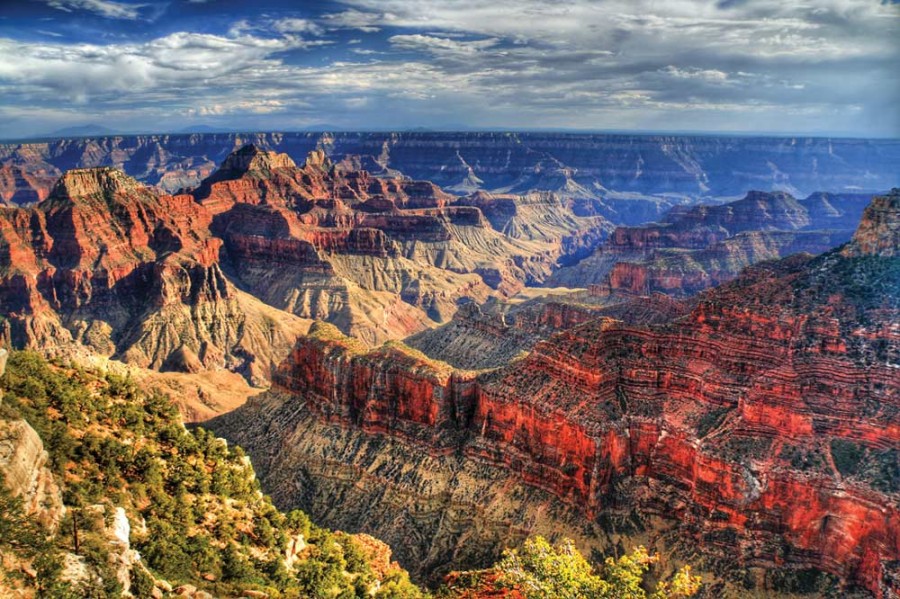Is There a Vast Cavern System of Tunnels and Chambers at the Grand Canyon?

The search for answers to the mystery of the alleged 1909 “underground “citadel” of tunnels and chambers, described by G. E. Kincaid as existing in the Grand Canyon has lead me to read several books on caves of the U.S. and the formation of caves, along with other aspects of caves and caving, in the hope that the research might shed more light on the possibility of such a massive underground “cavern-like” installation described by Kincaid, even being possible in the Grand Canyon.
I had already known that the Grand Canyon area had many caves and tubes, tunnels through rock and holes, etc., many of them described and first located by veteran Grand Canyon hiker, Dr. Harvey Butchart.
I was not prepared (although not surprised) for the information I discovered below, which hints at the possibility of a vast interconnected system of caverns in the Kaibab and Coconino plateau areas of the Grand canyon. (The north and south rim top geologic layers.)
To me, this strengthens the case for Kincaid’s alleged discovery being a modified cavern system, which is what I have maintained from the start of my research. – Jack Andrews 2001
In his book, ‘Depths Of The Earth – Caves and Caverns of the United States’ – William R. Halliday gives some interesting observations on caverns of northern Arizona’s Coconino Plateau region:
“…Those who dream of Butler Cave as potentially the world’s largest, however, must hasten. The explorers of Mammoth Cave and Flint Ridge – and of Jewel Cave – are not the only teams on the verge of a breakthrough.
Missouri-Tennessee – few of our greatest cave areas today can be denied a flickering chance at the title. And for those who dream of long shots indeed, our most magnificent cave area beckons irresistibly: the Grand Canyon.
“Perhaps in the purple shadows of the incomparable canyon there really is no chance for a truly great cave system. So believe some experts.
Perhaps our hopes here are gossamer dreams, strung together with wishful thinking. Here I claim no impartial judgment. My mind is hopelessly influenced by the long intimacy with the timeless beauty of that tranquil canyon. I have seen its magic pastels at moonrise over the mile-high rim, suddenly dramatized by the weirdly luminous flutter of bat wings. No caver brushed by such a spell is ever the same again.
“In this strange, magnificent country, much remains to be learned. Sinking streams, an occasional natural shaft, and plateau-top sink-holes tell of much more water vanishing underground than reappears in canyon-bottom springs.
Miles to the south, enormous sinks and remnants of a throughway type of cave are evidence of sometime profuse subterranean water flow. Fanning out from both rims of the mile-deep canyon are vast plateaus capped with limestone 500 feet thick. Yet caves seem few and tiny in these vast expanses of plateau-top limestone.
“The other massive limestones of the incomparable canyon lie 2,000 (feet) below. Above them are 1,500 feet of sandstone and shales which ought to block the downward flow of the water essential for cave development. Yet at this great depth occur the caves of the Grand Canyon. In the blazing, rock-tiered canyon, foot travel is difficult and progress slow.
Still, cave after cave is coming to carbide light in the purple-shadowed depths. Some are merely shallow alcoves, important only for archeological content. Others are colossal natural sewers, dwarfed only by their stupendous environs.
“Yet it is this often-scorned limestone of the plateaus which speeds the pulses of American caverns. Just south of the Grand Canyon, fluorescent chemicals introduced into a sucking ‘earth crack’ of the Coconino Plateau have been traced to a ‘breathing well’ 24 miles away.
Initial calculations somewhat like those of Jewel Cave suggest a minimum air volume here of more than 7 BILLION CUBIC FEET. Scientists of the famed RAND CORPORATION suspect the presence of hundreds of miles of narrow, interconnected caverns fissuring the vast plateau.
“Many a veteran caver may consider such a cavern system impossible. Perhaps it is, but Arizona caverns have already performed the impossible. In Sipapu Cavern, an earth crack near the Rand Corporation study site, they have descended 500 feet toward the massive cavernous limestone deep below. In this locale the surface limestone is only 248 feet thick. Half of their descent was through supposedly non-cavernous sandstone.
“If one of the rare dome-pits of the Kaibab Plateau intersects a washed-out section of a fault zone draining to a North Rim stream cave, a depth record will be within reach. Geologically such a circumstance is hardly more than a pipe dream of an irrepressible caver overcome by the magnificence of the Grand Canyon. But it may happen.
“Perhaps eager caverns plumbing the earth cracks of the Coconino Plateau have little more chance than beneath the Kaibab. But if those caverns can penetrate twice again as deeply as Sipapu Cavern, they will begin to enter the limestone where great sewer caves may lie. If such do exist, they may enlarge away from the great canyon rather than toward it.
They may not exist at all. Yet a cavernous network dwarfing that of Mammoth and Flint ridges may be penetrable here. Some day obsessed caverns may break through the Coconino sandstone barrier and the shales which underlie it. If that happens, those who follow in their footsteps may emerge triumphant from obscure orifices deep in the heart of the Grand Canyon.
“Even without such a triumph, even without knowledge of the hundreds of undiscovered caves which must exist hidden in limestone recesses of the mighty terraced depths, the Grand Canyon must be recognized as one of America’s great cave areas. To some, that recognition alone would be achievement. Yet sunbaked canyon caverns have much in common with their Appalachian fellows.
Until every crack is penetrated, every hole plumbed, spelunkers and speleologists alike will remain unsatisfied. Fragile indeed are the spelean threads which weave together Sipapu Cavern and Butler Cave, yet such are caverns’ secret dream.”



 Creators of mankind
Creators of mankind Description of “Tall white aliens”
Description of “Tall white aliens” Where they came from?
Where they came from? About hostile civilizations
About hostile civilizations The war for the Earth
The war for the Earth “Tall white aliens” about eternal life
“Tall white aliens” about eternal life Video: “Nordic aliens”
Video: “Nordic aliens” Aliens
Aliens Alien encounters
Alien encounters The aliens base
The aliens base UFO
UFO Technology UFO
Technology UFO Underground civilization
Underground civilization Ancient alien artifacts
Ancient alien artifacts Military and UFO
Military and UFO Mysteries and hypotheses
Mysteries and hypotheses Scientific facts
Scientific facts


















